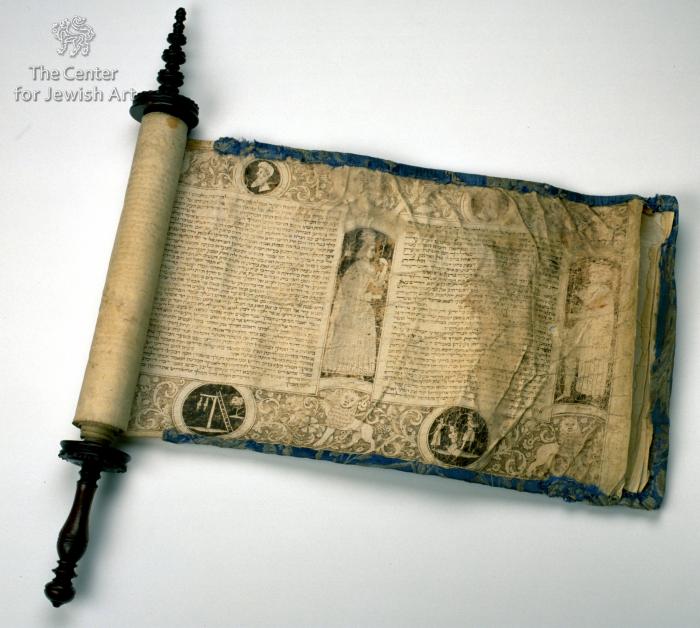Obj. ID: 23767
Hebrew Illuminated Manuscripts JHM Aryeh Leib ben Daniel of Goray Sepia Esther Scroll with Fabric, Italy (?), 1740s

The scroll is not signed but the ornamentation - executed in a pen and brown ink - features the style of Aryeh Leib ben Daniel of Goray (Pol. Goraj), Poland. The upper margins are lavishly decorated with medallions containing the busts of the king's advisers mentioned in Es. 1:10, chamberlains, and guardians of the harem. They are identified by their names written in a semi-cursive Hebrew script penned above medallions. The medallions are flanked by plants and flying birds which are separated by vases. The text is inscribed in rectangular panels, between which are illustrations of full-length figures representing the major characters of the Esther story, along with the princes of Media and Persia listed in Es. 1:14; they are identified by their names, which are inscribed with the same type of Hebrew script as above. The lower margins are adorned with roundels containing narrative scenes reflecting the Purim story with captions in the same script written below them. These roundels are flanked by plants with flowers and fruits and between them are lions with human faces (they are just below Esther story protagonists). Throughout the entire manuscript, the space between the larger ornamental elements is filled with a repetitive composition of leafy tendrils, flowers, and fruits (potentially grapes) that are shown against a background of imitation cross-hatching.
The scroll is mounted on a wooden turned roller. A piece of blue decorative fabric is sewn underneath two-thirds of the length of the first sheet.
The inscriptions at the opening section of the scroll are invisible.
P | Portrait | Portrait medallion
H | Human Figure | Bust (Human figure)
E | Esther, Book of (following the order of the story) | Esther story protagonists
L | Lion
B | Bird
F | Flower
O | Ornamentation: | Foliate and floral ornaments
F | Fruits
O | Ornamentation: | Main text framed
|
Lenght of the membranes in the scroll: 1) 630 mm, 2) 590 mm, 3) at least 550 mm.
Dimensions of the selected details in the scroll:
- text panel: 162x150 mm (inside);
- roundels in the lower margins: 50 mm (inside), 67 mm (outside);
- an average letter: more than 2 mm;
- spaces between the lines: more than 2 mm.
The roller: ca. 515 mm (height)
The first membrane is very poorly preserved; a part of the decorations is damaged and the text is barely visible in some places.
In general, the decorations are better preserved than the text.
The Book of Esther in Hebrew
The scroll is formed of 3 sheets, containing in total 8 columns of the text of 30, 33, or 34 lines each. Col. 7 includes 11 lines divided into two half-columns.
The first two membranes contain 3 columns of text; the third membrane also contains 3 columns but they are written in 2 panels.
The text is written in Hebrew square script in brown ink on the flesh side of the parchment membranes of medium thickness and stiffness, rather bright.
Some sections of the text contain tagim.
The letters ח (Es. 1:6) and ת (Es. 9:29) are enlarged and bolded but the first of them is barely visible. Other enlarged and diminished letters are included in col. 7.
The last line in col. 7 is filled with and ornamented; the previous lines contain many elongated letters.
The ruling made by a stylus is well visible along with the membranes.
The pricking is invisible.
The membranes in the scroll are stitched together.
A short characteristic and images are available on https://data.jck.nl/page/aggregation/jhm-museum/M000418 (accessed on 28.06.2021).
Dagmara Budzioch, The Decorated Esther Scrolls from the Museum of the Jewish Historical Institute in Warsaw and the Tradition of Megillot Esther Decoration in the Seventeenth and Eighteenth Centuries – An Outline [Polish: Dekorowane zwoje Estery z Żydowskiego Instytutu Historycznego w Warszawie na tle tradycji dekorowania megilot Ester w XVII i XVIII wieku. Zarys problematyki], Warsaw 2019, 1:206-215.
Ernest Namenyi, "The Illumination of Hebrew Manuscripts after the Invention of Printing," in Cecil Roth (ed.), Jewish Art, an Illustrated History (London, 1961), col. 435.
Mendel Metzger, The Earliest Engraved Italian Megilloth, Bulletin of the John Rylands Library 1966, 48/2, esp. 409, 422-425.
Olga Sixtova, O svitku / Form of the Scroll [katalog k výstavě konané v Galerii Roberta Guttmanna Židovského muzea v Praze od 22. června do 26. července 2006], Prag 2006, 32-33.
A Journey through Jewish Worlds: Highlights from the Braginsky Collection of Hebrew Manuscripts and Printed Books, eds. Evelyn M. Cohen, Emile Schrijver, Sharon Liberman Mintz, Amsterdam 2009, 246-249.
Schöne Seiten. Jüdische Schriftkultur aus der Braginsky Collection, eds. Emile Schrijver, Falk Wiesemann, Evelyn M. Cohen, Sharon Liberman Mintz, Menahem Schmeltzer, Zurich 2011, 266-269.
A Fine Illustrated Esther Scroll, [ca. 1740], lot 105, Sotheby's New York Important Judaica, 20 December 2017 https://www.sothebys.com/en/auctions/ecatalogue/lot.105.html/2017/important-judaica-n09687 (accessed on 31.07.2020).
A Magnificent Esther Scroll Written and illustrated Aryeh Leib ben Daniel of Goray, Schwelm, 1737, lot 187, Sotheby's New York Important Judaica Including Property from the Estate of Shlomo Moussaieff, 15 December 2016 https://www.sothebys.com/en/auctions/ecatalogue/2016/important-judaica-n09589/lot.187.html (accessed on 31.07.2020).













